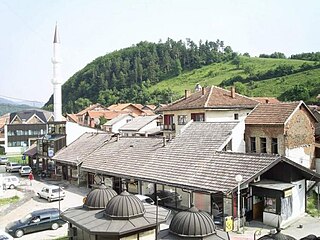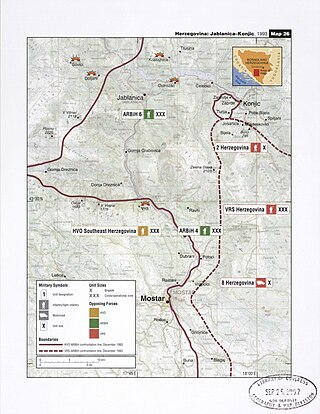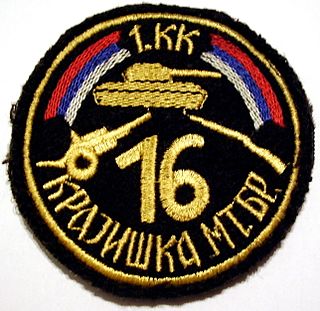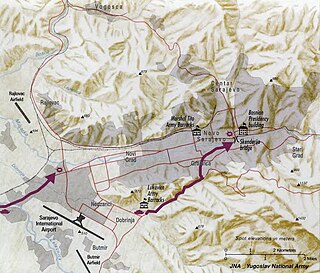
Gornji Vakuf-Uskoplje is a town and municipality located in Central Bosnia Canton of the Federation of Bosnia and Herzegovina, an entity of Bosnia and Herzegovina.

Operation Neretva '93 was an Army of the Republic of Bosnia and Herzegovina (ARBiH) operation against the Croatian Defence Council (HVO) in September 1993 on a 200 km long front from Gornji Vakuf to south of Mostar, one of its largest of the year, during the Croat–Bosniak War. The ARBiH made limited gains in the area of northern Herzegovina and around Mostar, but did not achieve a breakthrough to the southern Neretva, where the HVO retained control. The operation was halted in October. During the operation, dozens of Croat civilians were killed in the Grabovica and Uzdol massacres.
Operation Corridor 92 was the largest operation conducted during the Bosnian War by the Army of Republika Srpska (VRS) against the forces of the Croatian Defence Council (HVO) and the Croatian Army (HV) in the Bosanska Posavina region of northern Bosnia and Herzegovina between 24 June and 6 October 1992. The objective of the offensive was to re-establish a road link between the city of Banja Luka in the west of the country and the eastern parts of the territory controlled by the Bosnian Serbs. The offensive was prompted by the capture of Derventa by the HV and the HVO – a move that blocked the single overland road between the VRS-controlled territories.

Operation Spider were a series of military actions in northwestern Bosnia that began in November 1994 and continued until December 1994. It was a combined effort of Republika Srpska and the Republic of Serb Krajina to recover the territory of the Autonomous Province of Western Bosnia (APZB), which was a key ally of the Serbs. Franko Simatović and Jovica Stanišić commanded the offensive. The Bosnian central government had previously overrun and seized the territory. The offensive ended in a Serb victory and the Autonomous Province of Western Bosnia remained in existence until the fall of its key ally, the Republic of Serbian Krajina, and the subsequent end of the war.
Operation Jackal (Serbo-Croatian: Operacija Čagalj, also known as Operation June Dawns, was an offensive of the Bosnian War fought between a combined Croatian Army and Croatian Defence Council army against the Army of Republika Srpska from 7–26 June 1992. The offensive was a Croatian pre-emptive strike against the VRS, a Bosnian Serb military formed in May 1992 from Yugoslav People's Army units that were stationed in Bosnia and Herzegovina. The HV concluded that the JNA offensive operations of April and May 1992, resulting in the capture of Kupres and much of the Neretva River valley south of Mostar, were aimed at capturing or threatening the Croatian Port of Ploče and possibly Split. To counter this threat, the Croatian leadership deployed the HV, under the command of General Janko Bobetko, to the "Southern Front" including the area in which Operation Jackal was to be conducted.
The Battle of Kupres was a battle of the Bosnian War, fought between the Bosnian Croat Territorial Defence Force supported by the Croatian Army troops on one side and the Yugoslav People's Army, augmented by the Bosnian Serb TO on the other at the Kupres Plateau, on 3–11 April 1992. During the fighting on 8 April, the Bosnian Croat TO was reorganised as the Croatian Defence Council. The objective of the battle was to control the strategic Kupres Plateau, a major supply route.
Operation Una was a military offensive conducted by the Croatian Army against the Army of Republika Srpska in western Bosnia and Herzegovina on 18–19 September 1995, during the Bosnian War. The operation entailed a crossing of the Una and Sava rivers to establish bridgeheads at Novi Grad, Bosanska Dubica, Bosanska Kostajnica and opposite Jasenovac to allow for a subsequent advance towards Prijedor and Banja Luka.

The 16th Krajina Motorized Brigade was a motorized unit based in Banja Luka part of the 1st Krajina Corps of the Army of Republika Srpska.
Operation Bura was a joint offensive conducted by the Croatian Defence Council and the Croatian Army on the territories held by the Nevesinje and Bileća brigades of the Army of Republika Srpska during the Bosnian War.

The Battles on Ilidža were attacks executed by Bosnian Muslims (ARBiH) to capture Ilidža from the Yugoslav army (JNA). The reason why the Bosnians attacked the settlement of Ilidža was to widen the passage between Sarajevo and the rest of the country. Two major battles happened in the area, both turned into victories of the JNA with considerable losses on both sides. These played an important role in the further course of the Siege of Sarajevo.

The Attack on Teslić was an attempt by the Army of the Republic of Bosnia and Herzegovina (ARBiH) to take Teslić and the surrounding settlements from the Army of Republika Srpska (VRS) in October 1994 during the Bosnian War. All attacks on the city were successfully defended by the VRS. After the signing of the Washington Agreement in late march 1994, which ended the Croat-Bosniak War in the Tešanj-Maglaj enclave, the ARBiH saved significant forces that were on the front lines against the 111th Croatian Defence Council (HVO) brigade from Žepče and transferred them to the Serb front line towards Teslić.

The Battle of Azići was one of the battles in the Siege of Sarajevo in 1993. The VRS made its first step in the operation in the suburbs in early December 1992, breaking through the suburb of Otes, some 15 kilometers west of central Sarajevo. In the middle of February, the Sarajevo-Romanijan Corps started the second part of the campaign, attacked Aziće, the troops of the 1st Ilidžan Infantry Brigade attacked with support tanks and armored personnel carriers of the 1st Sarajevo Mechanized Brigade.

Operation Brana 94 was the name of the operation of the joint forces of the 3rd Corps of the Army of the Republic of Bosnia and Herzegovina (ARBiH), which began on June 1, 1994, from the direction of Zavidović and with shorter interruptions that lasted until 5 July 1994. In the end, the Serbs, with far fewer soldiers, managed to defend Vozuća.
The Battle of Foča took place from April 8 to 17 in 1992, when Bosnian Serbs and Serb volunteers from Montenegro invaded Foča and fought with the Territorial Defence Force of the Republic of Bosnia and Herzegovina (TORBIH). It was the site of one of the first battles in this war, along with the Siege of Sarajevo, Operation Višegrad, the Battle of Zvornik and the Battle of Kupres.

The Offensive on Teslić (1994) was the initial assault by the Army of the Republic of Bosnia and Herzegovina (ARBiH) on the town of Teslić during the Bosnian War.
Operation Bosanska Krajina was the code name of the Army of Republika Srpska (VRS) offensive during the Bosnian War which aimed to capture the municipalities of Prijedor, Sanski Most and Ključ. The offensive was also the response of the VRS to the Army of the Republic of Bosnia and Herzegovina (ARBiH) attack on the city of Prijedor. The operation ended with the victory of the VRS and the beginning of the siege of Bihać.

The attack on Stolice was an attempt by the ARBiH to control the positions of the VRS on Mountain Majevica. At first, the ARBiH suppressed the VRS, and a week later, the ARBiH attacked the VRS positions again, with which the VRS retaliated with a counterattack up to the top of Velika Jelica and returned part of the southern territory. The defense of Stolica and Banj brdo was carried out by the East Bosnian Corps of the Army of Republika Srpska.

The Trebava offensive started after the capture of Vis, which gave the Army of the Republic of Bosnia and Herzegovina motivation to go further. In the offensive, the Army of the Republic of Bosnia and Herzegovina tried to capture the peak of Duga Njiva, Skipovac, Zelinja, Paležnica, Sjenina and some other areas, and if they succeeded, they could put pressure on Modriča, just like when the Croatian Defence Council occupied Modriča in 1992 for a moment. In the end, they occupied only Skipovac, and could not break through because the Army of Republika Srpska fired artillery at them from peak of Duga Njiva, and they failed to capture the surrounding villages.

The Battle of Antunovac was a battle during the Croatian War of Independence. Fought between 20 November and 24 November 1991. It was fought between Croatia, and SAO Eastern Slavonia, Baranja and Western Syrmia which was supported by the Yugoslav People's Army. In the late afternoon of November 24, 1991, Antunovac was captured by the forces of the JNA and rebel Serbs.

Operation Majevica was the code name of the operation and an attempt by the Army of the Republic of Bosnia and Herzegovina (ARBiH) to control the peaks of Stolica, Banj brdo and occupy Lopare. This battle took place in the most difficult year of the Army of Republika Srpska (VRS), 1995, but despite all the attacks of the ARBiH, the VRS defended the villages of Priboj, Piperi, Vakuf, Brusnica, the peaks on Majevica and the repeater.













